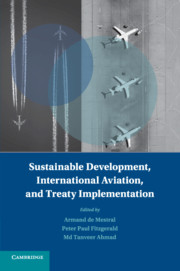Book contents
- Sustainable Development, International Aviation, and Treaty Implementation
- Treaty Implementation for Sustainable Development
- Sustainable Development, International Aviation, and Treaty Implementation
- Copyright page
- Contents
- Figures
- Tables
- Contributors
- Introduction
- Part I Current Status of Global Aviation and Sustainable Development
- Part II Regional Aviation Issues
- 5 Sustainable Development and Emission Trading
- 6 Exporting Environmental Values through Open Skies
- 7 Aviation and Sustainable Development
- 8 Sustainable Aviation and the Transfer of Environmentally Sound Technologies to Africa
- 9 Sustainable Tourism and the Impact of Climate Change on the Caribbean
- Part III Dispute Settlement
- Part IV Future Directions
- Conclusion
- Index
7 - Aviation and Sustainable Development
Some Perspectives from the Asia-Pacific
from Part II - Regional Aviation Issues
Published online by Cambridge University Press: 22 August 2018
- Sustainable Development, International Aviation, and Treaty Implementation
- Treaty Implementation for Sustainable Development
- Sustainable Development, International Aviation, and Treaty Implementation
- Copyright page
- Contents
- Figures
- Tables
- Contributors
- Introduction
- Part I Current Status of Global Aviation and Sustainable Development
- Part II Regional Aviation Issues
- 5 Sustainable Development and Emission Trading
- 6 Exporting Environmental Values through Open Skies
- 7 Aviation and Sustainable Development
- 8 Sustainable Aviation and the Transfer of Environmentally Sound Technologies to Africa
- 9 Sustainable Tourism and the Impact of Climate Change on the Caribbean
- Part III Dispute Settlement
- Part IV Future Directions
- Conclusion
- Index
Summary
The rapid growth of passenger and freight traffic in the Asia-Pacific region has come in hand with greater environmental concerns. Affirming its growing influence, the Asia-Pacific has widely contributed to recent ICAO actions to develop multilateral bases for market-based environmental measures in international aviation as an avenue to mitigate greenhouse gas (GHG) emissions. States in the Asia-Pacific regions also have engaged in some laws and policies aimed at contributing to climate change mitigation, in particular by reducing GHG emissions. Yet, there is no broad consistency in the measures undertaken, or a particular focus on international aviation. Individual states in the Asia-Pacific region have approached the objective of mitigating aviation impacts very differently, from countries that have only adopted embryonic climate laws to countries with fully operational carbon-pricing schemes. Given the spirit of the Chicago Convention 1944, it is principally important to make every effort to come up with a global approach through the ICAO. However, alternative approaches should also be considered. The alternatives may well stem from the “bottom-up” collective linkages being created between regional or single-state ETSs, such as the bilateral trade link that will be forged between the EU and Australia. This model of cooperation could be an alternative to stalling multilateral negotiations on a global regime.
- Type
- Chapter
- Information
- Publisher: Cambridge University PressPrint publication year: 2018
- 1
- Cited by



